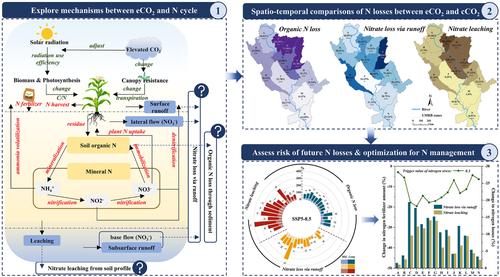Assessing the Response Mechanisms of Elevated CO2 Concentration on Various Forms of Nitrogen Losses in the Golden Corn Belt
IF 5.4
3区 材料科学
Q2 CHEMISTRY, PHYSICAL
引用次数: 0
Abstract
Nitrogen (N) loss is a significant source of water quality pollution in alluvial watersheds. However, the mechanisms linking N loss and elevated CO2 concentration (eCO2) are not well recognized. In this study, we comprehensively calibrated the SWAT model equipped with a dynamic CO2 input and response module to investigate the response mechanisms between multiform N losses and eCO2 in a representative large‐scale watershed. Results revealed nitrate loss under eCO2 exceeding 100% in some upstream zones under the SSP5‐8.5 scenario (P < 0.05) compared to the constant CO2 concentration. This was directly related to the great increase in hydrological variables, which were the carriers of N losses, and the intensive inputs of N fertilizer. Results also found that nitrate leaching was greater than the other two processes for future periods, peaking at 309.3%, as compared to the baseline period. The findings suggested reducing fertilizer inputs by 10%–20% was promising, especially for reducing nitrate loss through runoff and leaching by up to 17.7% and 12.2%. This study explored the mechanisms of increased N loss in response to eCO2 and provided scientific evidence for early warning and making decisions to improve water quality at a large watershed scale.

评估二氧化碳浓度升高对黄金玉米带各种形式氮损失的响应机制
氮(N)流失是冲积流域水质污染的一个重要来源。然而,氮流失与二氧化碳浓度(eCO2)升高之间的关联机制尚未得到充分认识。在本研究中,我们对配备了二氧化碳动态输入和响应模块的 SWAT 模型进行了全面校准,以研究具有代表性的大尺度流域中多种形式的氮损失与 eCO2 之间的响应机制。结果表明,与恒定 CO2 浓度相比,在 SSP5-8.5 情景下,eCO2 条件下部分上游区域的硝酸盐流失量超过 100%(P < 0.05)。这与作为硝酸盐流失载体的水文变量的大幅增加以及氮肥的大量投入直接相关。结果还发现,与基线期相比,硝酸盐沥滤在未来时期比其他两个过程都要大,最高达到 309.3%。研究结果表明,将化肥投入量减少 10%-20%是很有前景的,尤其是可将通过径流和沥滤造成的硝酸盐流失分别减少 17.7% 和 12.2%。这项研究探索了氮流失增加对二氧化碳排放的影响机制,为预警和决策提供了科学依据,以改善大流域范围内的水质。
本文章由计算机程序翻译,如有差异,请以英文原文为准。
求助全文
约1分钟内获得全文
求助全文
来源期刊

ACS Applied Energy Materials
Materials Science-Materials Chemistry
CiteScore
10.30
自引率
6.20%
发文量
1368
期刊介绍:
ACS Applied Energy Materials is an interdisciplinary journal publishing original research covering all aspects of materials, engineering, chemistry, physics and biology relevant to energy conversion and storage. The journal is devoted to reports of new and original experimental and theoretical research of an applied nature that integrate knowledge in the areas of materials, engineering, physics, bioscience, and chemistry into important energy applications.
 求助内容:
求助内容: 应助结果提醒方式:
应助结果提醒方式:


